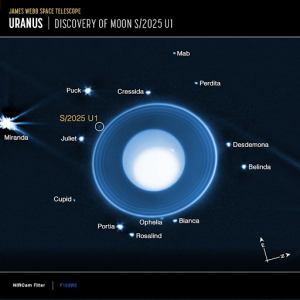Using the James Webb Space Telescope owned by NASA, a research team was able to spot a previously undetected moon orbiting Uranus in February. This discovery brings Uranus’s total number of moons to 29.
“This object was spotted in a series of 10 40-minute long-exposure images captured by the Near-Infrared Camera (NIRCam),” said Maryame El Moutamid, who heads the Southwest Research Institute’s Solar System Science and Exploration Division out of Boulder, Colorado.
El Moutamid and her colleagues are responsible for this important discovery, expanding our knowledge of Uranus.
The Voyager 2 spacecraft flew past the planet in the mid 80’s, but didn’t manage to spot the object likely due to its small size, as the moon is only six miles (10 kilometers) in diameter.
The unnamed moon joins the ranks of Uranus’s 13 small inner moons that orbit close to the planet. All of the planet’s moons are named after characters from Shakespeare or Alexander Pope. This new moon’s name will have to be greenlit by the International Astronomical Union (IAU), the group that governs and regulates the names for astronomical bodies.
The new technology of the James Webb Space Telescope enabled it to see this new moon where 40 years before, the Voyager 2 spacecraft couldn’t. El Moutamid is hopeful that the telescope will continue to shape our knowledge of the edges of our solar system and provide a clearer window into outer space.
“Through this and other programs, Webb is providing a new eye on the outer solar system. This discovery comes as part of Webb’s General Observer program, which allows scientists worldwide to propose investigations using the telescope’s cutting-edge instruments. The NIRCam instrument’s high resolution and infrared sensitivity make it especially adept at detecting faint, distant objects that were beyond the reach of previous observatories,” El Moutamid said.
El Moutamid emphasized the importance of using modern techniques to push the boundaries of what we know about our universe, contributing to the common goals of missions like Voyager 2 by using technology that we didn’t have 40 years ago.
“Looking forward, the discovery of this moon underscores how modern astronomy continues to build upon the legacy of missions like Voyager 2, which flew past Uranus on Jan. 24, 1986, and gave humanity its first close-up look at this mysterious world. Now, nearly four decades later, the James Webb Space Telescope is pushing that frontier even farther,” El Moutamid added.















